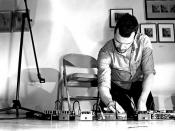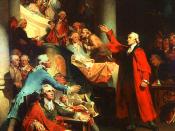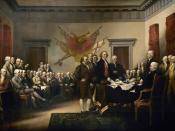During the beginning of the Revolution many documents, speeches and drawings were created in an attempt to unify the colonists and fight the British tyranny. Of these documents, there were three that played an important role in the Revolution. These three documents used similar writing methods to persuade colonists into one common goal; rallying against Great Britain.
All three of these documents were persuasive speeches, written to unify the colonists. None of the documents were actually written to be read, but rather written to be spoken. They are written so that anyone of any intellect would be able to comprehend them.
Of the many rhetorical devices they used rhetorical questions many times in their speeches in order to regain focus from their listeners, and add extra emotion. Patrick Henry, the writer of the Speech in the Virginia Convention used many rhetorical questions throughout his writing. He asks questions such as, " Are fleets and armies necessary to a work of love and reconciliation? Have we shown ourselves so unwilling to be reconciled that force must be called in to win back our love? " Using this type of questioning he is able to state his opinion, and he doesn't allow much time for protest.
It forces his listeners to think about the points he is making, and it usually persuades them into his point of view.
All of these documents included many examples of anaphora. The use of anaphora helped emphasize many important points of the documents. Thomas Jefferson, the writer of the Declaration of Independence, used the word 'he' to start out many of his sentences when referring to Great Britain. The repeating of the word 'he' at the beginning of each sentence helped with the flow of the piece, and also displayed negativity towards the king.


